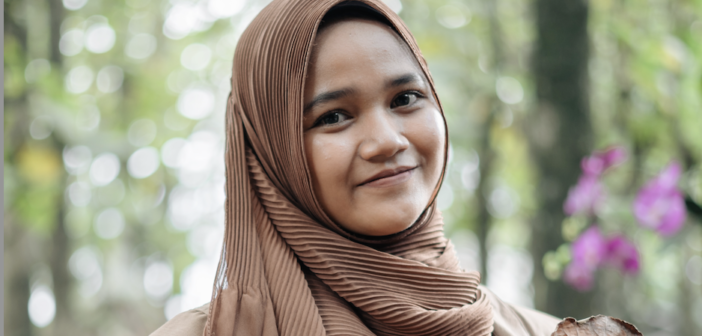Perhaps one of the most challenging aspects of motherhood with chronic illness is helping your children understand what is going on with your body and encouraging acceptance about how your illness may impact them. How can you help them develop empathy about what you’re experiencing, especially if your illness is invisible? Where’s the line between being honest and making them worry? What’s the best way to address their concerns in kid-friendly language? This is a topic that will likely need to be an ongoing discussion in your family – and sometimes reading a book together can help!
Mommy Sayang
by Rosana Sullivan
Stephanie Tignor received a copy of this book as a gift from Mamas Facing Forward. She was not compensated for this review and all opinions are her own.
Rosana Sullivan’s Mommy Sayang is a touching story for young children about a joyfully close-knit mother-daughter relationship, and the major challenge they face when their lives are disrupted by an unknown major illness for the mother. Sullivan, inspired by her mother’s paintings of her childhood kampung in Malaysia, lovingly depicts Malaysian culture and the Islam religion in the book. The many allusions and direct references to both reminded me of my own experience traveling to Malaysia and staying in a Malay kampung, or village, specifically one inhabited by Muslim Malays, the dominant ethnic group in Malaysia. Sullivan’s endearing pastel depictions of life in the kampung reveal the pleasures of rural Malaysian life: we see a gold dome-topped mosque centered between rice paddy fields and a collection of rustic wooden houses on stilts, and we notice small informal gatherings of community members, young and old, living life together peacefully, simply, and with a sense of joy and collaboration. Throughout the book, she takes advantage of every opportunity to bring the reader into Malaysia through its sounds, tastes, smells, and sights: the call to prayer, electric pink rambutan, sweet and salty nasi lemak, vibrant hibiscus, the thickness of warm curry, and even the warm pungency of a durian. Sullivan is eager and proud to welcome us to the kampung.
Sullivan’s charmingly drawn images of life in the kampung provide the backdrop of the story of Aleeya, a darling little girl with messy dark curls and a persistent adoration for her loving mother, Mommy Sayang, who is unmistakably Malay in her floral-patterned sarong, flat flip flop sandals, and blue tudong, or hijab-like head covering. Mommy Sayang and Aleeya enjoy an idyllic connection as mother-daughter and their bond seems to grow ever stronger through everyday moments together: hanging laundry from a line, splashing in the spray of a water hose, and cooking a big pot of curry together. In Aleeya’s barefooted dreams, they joyfully dance together, frolicking among twisted vine motifs of the hibiscus flower…until they don’t.
Sullivan abruptly transitions the short children’s story into an unmarked period in which Mommy Sayang and Aleeya are separated due to Mommy’s mysterious, unnamed illness. Concerned Aunties look on as Aleeya’s vibrant smile and boundless joy are erased and she longingly awaits her mother’s recovery. Wrapped in the comfort of her mother’s colorful sarong, the sight of a hibiscus plant, the Malaysian national flower, reminds Aleeya of her mother’s promise that she would always be by her daughter’s side (“inshallah”/“God willing”). Aleeya’s determination to approach her bedridden mother with the thoughtful gift of a freshly picked hibiscus, a symbol of courage, helps provide Mommy Sayang with the bravery she needs to face her serious illness with her daughter at her side, and little by little, Mommy recovers.
Though Sullivan doesn’t dig very deep into the topic of being the child of someone suffering from a chronic illness, or parenting as someone who has a chronic illness, in the inscription she alludes to her mom’s “long journey,” and in the postface she explains that her mother became very ill at some point in her childhood, and as a result, art became her “outlet and comfort.” Knowing that Sullivan faced a similar situation to Aleeya’s character in the story, I found it somewhat surprising that she left Mommy Sayang’s illness largely undefined and ambiguous, and that she resolved the story through a somewhat simplistic, magical, and perhaps even unrealistic ending: “Mommy felt better.”
On one hand, the ambiguity of Mommy’s illness makes the story potentially relevant to a wider variety of readers who might be able to relate it to any number of illnesses or conditions: for example, COVID-19, flu, autoimmune disease, depression, or even cancer. On the other hand, without a better explanation of the mother’s illness, and the remedy that helped her resume days of endless joy with Aleeya on the kampung, the story risks misrepresenting the realities of life with a chronic illness, and at worst, minimizing or even ignoring the impact of chronic illness on children, parents, families, and communities. Additionally, the implications of Aleeya stating her intentions to always be by Mommy Sayang’s side might be problematic to readers averse to caregiver guilt, especially among young children.
As someone who, as a child, lived with a parent with multiple sclerosis, and currently has rheumatoid arthritis as a mother of three, I would find the story’s sudden, almost magical, resolution of Mommy Sayang’s illness insulting or even dangerous, if I didn’t so enjoy the rich images of Malaysian life and the moments of joy between the mother and daughter which remind me of my own mother-daughter relationships. However, though I try to be clear and forthright with my own three small children when it’s appropriate, I’ll admit that sometimes it is better for them when explaining something complex or distressing (like chronic illness), to simplify and soften language to help them understand (e.g. “mommy has booboos inside her fingers”), and that’s something Sullivan does very well in this story: she softens the blow to create a more tolerable, widely-relevant story. Therefore, due to the simplistic nature of how this book addresses chronic illness in a parent, it is probably most appropriate for children under the age of five. Children will enjoy the illustrations, and especially the whimsical nature of Aleeya’s dream sequence.
I applaud Sullivan for creating a book with positive representations of Asians and Muslims, as well as life in a country outside the U.S. that offers readers unfamiliar with Malaysian culture a lesson in cultural diversity and awareness. Sullivan provides helpful translations of a few Malay words, and shows aspects of Malay life that may be enlightening for some readers: daily prayer, typical Malaysian cuisine, Malaysian art, and even Mommy Sayang without her tudong on her head while she is presumably reading the Koran in the privacy of her home. Even the gathering of friends, family, and neighbors for a meal signals the community-centeredness and collectivism of Malaysian culture. These sometimes subtle, but clear examples of everyday life in the kampung make Mommy Sayang a valuable tool for those looking to expose children to different cultures and religions.
📚📚Want to purchase your own copy of “Mommy Sayang”? 📚📚Please use our Amazon Affiliates link by clicking here! Mamas Facing Forward may receive commission at no extra cost to you. Those funds will go towards providing more resources for moms and moms-to-be living with chronic illness, so thanks for using our links!




